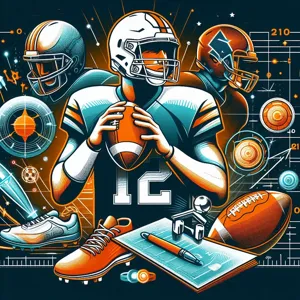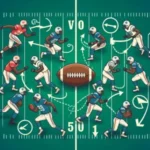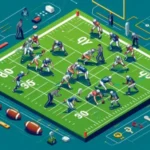In American football, the quarterback is often hailed as the heartbeat of the team, orchestrating plays and leading the offense with precision and poise.
Yet, no matter how talented a player may be, the key to success lies in one critical skill: accuracy. A quarterback’s ability to deliver the ball with pinpoint precision can make or break a game, transforming potential turnovers into touchdowns. In this blog post, we will explore the top techniques that can elevate a quarterback’s accuracy to new heights, from footwork drills and body mechanics to mental exercises designed to sharpen focus and decision-making under pressure. Whether you’re a coach looking to refine your players’ skills or a budding quarterback striving for greatness, these strategies will help you master the art of precision passing, ensuring that every throw counts when it matters most.
1. Understanding the Importance of Quarterback Accuracy

Quarterback accuracy is the cornerstone of an effective offensive strategy in American football. It is not merely a statistic; it is a critical component that can make or break a game. A quarterback who can consistently place the ball where it needs to be can transform a team’s performance, turning challenging situations into scoring opportunities.
Imagine a game scenario: the pocket collapses, defenders are closing in, and the quarterback must make a split-second decision. If he can throw an accurate pass, he can hit a receiver in stride, allowing them to gain crucial yards or even score a touchdown. Conversely, an inaccurate throw can lead to turnovers, missed opportunities, and ultimately, a loss on the scoreboard.
Accuracy goes beyond just hitting a target; it encompasses timing, trajectory, and the ability to read the defense. A precise quarterback anticipates the movements of their receivers and delivers the ball before they even make their cuts. This requires not only a strong arm but also an acute understanding of the game, including defensive schemes and player tendencies.
Furthermore, an accurate quarterback instills confidence in their teammates. Receivers know they can rely on their quarterback to deliver the ball where it needs to be, which can enhance their performance and aggression on the field. This trust is essential for building a cohesive unit, as every player must be in sync to execute plays successfully.
In essence, quarterback accuracy is about more than just numbers; it is a vital skill that influences the dynamics of the entire team. By understanding its importance, players and coaches can focus on developing techniques that will elevate performance, paving the way for victories on the field.
2. Key Fundamentals of Quarterback Mechanics
When it comes to enhancing quarterback accuracy, mastering the key fundamentals of quarterback mechanics is paramount. These foundational elements serve as the bedrock upon which every successful throw is built. To elevate your game, focus on the following critical aspects:
1. **Footwork**: The foundation of any great throw lies in solid footwork. A quarterback should maintain a balanced stance, with feet shoulder-width apart and weight distributed evenly. Quick, precise foot movements allow for better positioning and stability, enabling the quarterback to align their body with the target. Practicing dropbacks and set-up drills helps develop muscle memory, ensuring that footwork becomes second nature during high-pressure situations.
2. **Body Alignment**: Proper body alignment is crucial for accuracy. The quarterback’s shoulders, hips, and feet should all align toward the target when throwing. This alignment allows for a more fluid motion and reduces the chances of off-target throws. Quarterbacks should practice drills that emphasize the importance of keeping their body in line with their intended target, ensuring that every throw is executed with precision.
3. **grip and Release**: A firm grip on the football is essential for control and accuracy. The quarterback should hold the ball with their fingertips, keeping their thumb underneath for support. The release point is equally vital; an optimized release, ideally at shoulder height, allows for a more controlled throw with less chance of wobbling. Drills focusing on grip strength and release timing can significantly improve a quarterback’s throwing consistency.
4. **Follow-Through**: The follow-through is often overlooked but is a critical component of throwing mechanics. A proper follow-through ensures that the ball travels with the desired velocity and trajectory. After releasing the ball, the quarterback should allow their throwing arm to extend fully, with their wrist snapping downwards. This motion not only enhances accuracy but also helps prevent injuries by promoting a natural throwing motion.
5. **Visualization**: Lastly, mental preparation is just as important as physical mechanics. Visualizing successful throws can help establish confidence and improve focus. Quarterbacks should take time to mentally rehearse their throws, visualizing everything from foot placement to the trajectory of the ball. Incorporating this mental aspect into practice can lead to improved on-field performance.
By honing these key fundamentals of quarterback mechanics, players can develop a more accurate throwing technique, leading to greater success on the field. Consistent practice and a commitment to mastering these elements will not only enhance accuracy but also elevate the overall performance of any quarterback.
3. Drills to Improve Throwing Technique

When it comes to boosting quarterback accuracy, refining throwing technique is paramount. A quarterback’s throwing motion is a complex interplay of mechanics, timing, and body alignment, which means that a focused approach to drills can yield significant improvements. Here are some essential drills that can enhance a quarterback’s throwing technique:
**1. The Wall Drill:** This drill emphasizes the mechanics of the throwing motion by requiring the quarterback to throw against a wall. The key is to stand about five to ten feet away from the wall and throw the ball with proper wrist snap and follow-through, ensuring that the elbow stays above the shoulder. This drill helps reinforce good form and ensures the quarterback is using the correct motion without the distraction of a moving target.
**2. Target Practice:** Set up various targets at different distances and heights to help quarterbacks develop their precision. Using cones, hula hoops, or even large buckets, quarterbacks can practice aiming for specific spots. This drill not only improves accuracy but also helps players learn to adjust their throws based on the receiver’s position and the dynamics of the game.
**3. The Three-Step Drop Drill:** Timing is crucial in football, and this drill focuses on the quarterback’s footwork during a three-step drop. The quarterback takes three quick steps back from the line of scrimmage and, while maintaining balance, executes a throw to a designated target. This drill reinforces the connection between footwork and accuracy, ensuring that the quarterback is stable and poised when making a throw under pressure.
**4. One-Knee Drill:** This is a fantastic drill for teaching proper mechanics while simplifying the throwing motion. By having the quarterback kneel on one knee, they can concentrate solely on their upper body mechanics without worrying about stepping into the throw. This drill is particularly effective for reinforcing the importance of upper body strength and core stability in delivering accurate passes.
**5. The Quick Release Drill:** Often, the difference between a completed pass and an interception lies in how quickly a quarterback can release the ball. This drill encourages rapid decision-making and quick mechanics. Set up a series of targets at varying distances and angles, and have the quarterback practice throwing the ball within a set time frame. Emphasizing quick footwork and hand placement, this drill will help quarterbacks learn to release the ball faster while maintaining accuracy.
Incorporating these focused drills into regular practice routines will significantly enhance a quarterback’s throwing technique and, ultimately, their accuracy on the field. The more time spent honing these skills, the more prepared they will be to make precise, game-changing throws when it matters most.
4. The Role of Footwork in Accuracy
Footwork is often the unsung hero of quarterback accuracy, serving as the foundation upon which precision throwing is built. A quarterback’s ability to make accurate passes is significantly influenced by their footwork; it determines balance, timing, and ultimately, the trajectory of the throw. When a quarterback’s feet are well-aligned and in sync with their upper body movement, the chances of delivering a pinpoint accurate pass increase dramatically.
To master footwork, quarterbacks need to focus on a few key techniques. First and foremost, the stance is crucial. A solid, athletic base allows for quick lateral movements and explosive launches. Quarterbacks should practice a balanced stance that positions their feet shoulder-width apart, ready to pivot and respond to the rapidly changing dynamics of the game.
Additionally, drills that emphasize foot placement can help quarterbacks develop muscle memory for optimal positioning. For instance, the “five-step drop” drill encourages smooth transitions from the pocket, ensuring that each step is purposeful and controlled. This drill not only aids in developing rhythm but also helps quarterbacks maintain their balance as they prepare to throw under pressure.
Another essential aspect of footwork is the ability to throw on the run. Quarterbacks must learn to adjust their foot positioning while moving, allowing them to maintain accuracy even when they’re not set in a traditional throwing stance. Practicing rolling out and planting the back foot ensures that a quarterback can generate power and accuracy, regardless of their position on the field.
Finally, incorporating agility and speed training into a quarterback’s routine can enhance overall footwork. Quick feet allow for sharper cuts and more fluid movements, enabling quarterbacks to escape pressure and find throwing lanes. By honing these footwork techniques, quarterbacks can significantly improve their accuracy, making them a formidable force on the field.
5. Enhancing Vision and Field Awareness

Enhancing vision and field awareness is a crucial component in the development of a quarterback’s accuracy. A quarterback must possess the ability to quickly scan the field, recognizing defensive formations, identifying open receivers, and making split-second decisions that can mean the difference between a touchdown and a turnover. This level of awareness doesn’t come naturally; it requires dedicated practice and strategic training.
One effective technique to boost a quarterback’s field vision is through film study. Analyzing game footage allows players to see the field from a different perspective, helping them understand how different defenses react to various offensive plays. By recognizing patterns and tendencies, quarterbacks can anticipate where to look and when to throw, which ultimately leads to more accurate passes.
In addition to film study, on-field drills can significantly enhance a quarterback’s awareness. One popular drill is the “progression read” exercise. In this drill, quarterbacks practice going through their mental checklist of receivers while under simulated pressure, forcing them to maintain focus on their targets while being aware of the defense’s movements. This not only sharpens their decision-making skills but also builds confidence in their ability to deliver accurate throws, even in high-pressure situations.
Another effective method is to incorporate vision training exercises, such as using colored cones or balls to improve depth perception and peripheral awareness. By honing their visual acuity, quarterbacks can better track multiple players and quickly assess their options, making it easier to spot open lanes or receivers downfield.
Lastly, fostering a strong rapport with wide receivers enhances communication and trust on the field. The more quarterbacks and receivers work together, the better they can anticipate each other’s movements. This synergy not only leads to better timing on passes but also builds a deeper understanding of the game, ultimately boosting accuracy.
In the fast-paced world of American football, enhancing vision and field awareness is a game changer for quarterbacks. By investing time in these techniques, players can significantly improve their performance, leading to more successful drives and a greater chance of victory.
6. Utilizing Target Practice to Sharpen Precision
Target practice is an essential component in the toolkit of any quarterback aiming to enhance their accuracy. By honing in on specific targets, quarterbacks can develop muscle memory, improve their hand-eye coordination, and refine their throwing mechanics. The beauty of target practice lies in its adaptability; it can be tailored to suit quarterbacks of all skill levels, from high school hopefuls to seasoned pros.
To implement effective target practice, start by setting up various targets at different distances and angles. These can range from stationary objects like cones and barrels to more dynamic targets, such as moving receivers or even a coach simulating defensive pressure. By varying the target sizes — from large to small — quarterbacks can challenge themselves and gradually build their confidence and precision.
Incorporating drills that mimic game scenarios is crucial. For instance, quarterbacks can practice throwing on the run, making quick decisions under pressure, or hitting targets while rolling out. By simulating conditions they will face during actual games, quarterbacks can learn to adjust their throws based on the movement of their targets, thereby improving their situational awareness.
Additionally, using technology can enhance this practice. Tools like laser-guided targets or virtual reality simulators can provide immediate feedback on throwing accuracy and mechanics. Coaches can analyze the data collected from these sessions, identifying patterns and areas for improvement, ensuring that each practice is not only productive but also tailored to the quarterback’s unique playing style.
Ultimately, the goal of target practice is to build a quarterback’s confidence and precision. As they see improvement in their ability to hit targets consistently, they will carry that confidence onto the field, translating into more accurate throws during games. This focused, systematic approach to honing accuracy is a game-changer, making it an indispensable technique for any quarterback determined to elevate their performance.
7. The Impact of Strength and Conditioning on Accuracy

When it comes to quarterback accuracy, the importance of strength and conditioning cannot be overstated. While many fans may focus solely on a quarterback’s throwing mechanics and footwork, the physical foundation established through strength training and conditioning plays a crucial role in enhancing performance on the field.
A well-conditioned quarterback possesses the stamina to maintain peak performance throughout the game, allowing them to make precise throws even in high-pressure situations. Strength training not only improves muscle power but also contributes to better balance and stability—essential elements for delivering accurate passes. For instance, a strong core helps a quarterback maintain proper posture during throws, which directly affects the ball’s trajectory and spiral.
Incorporating exercises that target the shoulders, arms, and legs can significantly enhance a quarterback’s throwing power and control. Plyometric drills, resistance training, and agility exercises help develop explosive strength, enabling quarterbacks to generate speed and power while remaining agile in the pocket.
Moreover, conditioning drills that mimic game scenarios can improve muscle memory and reaction time, allowing quarterbacks to execute plays with greater precision under pressure. Whether it’s sprinting to evade a defender or making a quick release to hit a receiver in stride, a solid strength and conditioning program equips quarterbacks with the physical tools they need to succeed.
Ultimately, the interplay between strength, conditioning, and accuracy is undeniable. Coaches and trainers should prioritize a well-rounded fitness regimen that not only focuses on arm strength but also on overall athleticism, ensuring that quarterbacks are not only accurate but also resilient and quick-thinking when it matters most on the field. By embracing this holistic approach, quarterbacks can elevate their game, enhance their accuracy, and lead their teams to victory.
8. Analyzing Game Film for Improvement
Analyzing game film is one of the most powerful tools in a quarterback’s arsenal for improving accuracy. This technique goes beyond mere observation; it requires a deep, analytical approach to understanding both individual performance and overall game strategy. By breaking down footage from games, quarterbacks can pinpoint their strengths and weaknesses and make informed adjustments to their techniques.
When reviewing game film, the focus should be on specific throws—how they were executed, the decision-making process behind them, and the context in which they occurred. This includes examining the mechanics of each throw: Was the footwork aligned with the target? Did the quarterback maintain proper balance? Were the hips and shoulders in sync during the throw? By closely scrutinizing these elements, quarterbacks can identify patterns that lead to inaccuracies, whether it’s a tendency to over-throw or under-throw certain routes.
Moreover, analyzing game film isn’t just about personal performance; it also involves understanding defensive schemes and how they affect passing accuracy. By studying how defenses react to different offensive formations or play calls, quarterbacks can learn to anticipate defensive shifts and make quicker, more precise decisions under pressure. This insight allows them to adjust their pre-snap reads and develop a more strategic approach to each game.
Additionally, incorporating feedback from coaches and fellow players during film sessions can enhance learning. Collaborative discussions about specific plays can reveal perspectives that a quarterback might not have considered, leading to a richer understanding of the game. Engaging with teammates helps build a cohesive game plan where the quarterback and receivers are on the same page, ultimately increasing the probability of successful completions.
Incorporating regular film study into a training routine fosters a mindset of continuous improvement. As quarterbacks analyze their performances week after week, they develop a keen eye for detail and an instinct for recognizing what needs to change. This dedication to self-improvement not only sharpens their skills but also builds confidence, allowing them to perform with poise and accuracy on game day. By committing to this analytical practice, quarterbacks can elevate their game, ensuring they are always striving for precision in their craft.
9. Mental Preparation: Developing Focus and Confidence
In the high-stakes world of American football, physical skills are just one piece of the puzzle for a successful quarterback. Mental preparation is equally crucial, acting as the bedrock for both focus and confidence on the field. To achieve accuracy in passing, a quarterback must cultivate a strong mental game that allows them to remain calm under pressure and make split-second decisions.
Visualization is one of the most effective techniques for mental preparation. By picturing successful plays before they happen, quarterbacks can create a mental blueprint of their performance. This practice not only helps to build confidence but also trains the brain to respond effectively during the chaos of a game. Imagine standing in the pocket, visualizing the ideal throw to a receiver breaking open—this mental rehearsal can translate into real-life success when the game clock is ticking down.
Additionally, mindfulness exercises can significantly enhance focus. Techniques such as controlled breathing or meditation allow quarterbacks to clear their minds of distractions and maintain concentration in crucial moments. By learning to focus on the present, they can better read defenses, assess their options, and deliver accurate throws, even when the pressure is mounting.
Confidence, meanwhile, is a byproduct of preparation and experience. A quarterback who practices diligently—working on footwork, decision-making, and route recognition—will naturally build a reservoir of confidence that can be tapped into during games. positive self-talk and affirmations can further reinforce this mindset, reminding them of their skills and past successes.
Ultimately, mental preparation is a multifaceted approach that combines visualization, mindfulness, and confidence-building strategies. By prioritizing this aspect of their training, quarterbacks can significantly enhance their accuracy on the field, making them formidable leaders and playmakers in the game of football. As they cultivate this mental toughness, they become not just better athletes, but also more resilient competitors ready to face any challenge head-on.
10. Incorporating Technology: Using Analytics and Tools
In the ever-evolving landscape of American football, technology has emerged as a game-changer, especially when it comes to enhancing quarterback accuracy. Gone are the days when players relied solely on intuition and physical conditioning; today, analytics and advanced tools play a pivotal role in refining a quarterback’s skill set.
One of the most effective ways to incorporate technology into training is through video analysis. By recording practice sessions or games, quarterbacks can review their mechanics, footwork, and decision-making processes in real time. Tools like Hudl and Coach’s Eye allow coaches and players to break down plays frame by frame, identifying areas for improvement that might go unnoticed in the heat of the moment. This visual feedback is invaluable, enabling quarterbacks to correct issues in their throwing motion or stance, ultimately leading to improved accuracy.
Additionally, wearable technology, such as GPS trackers and heart rate monitors, provides insights into a quarterback’s physical performance. These devices can track metrics like speed, distance covered, and even throwing velocity, helping players understand how their physical condition impacts their accuracy. When combined with data analytics, quarterbacks can tailor their training regimens to focus on specific areas that require enhancement, ensuring that they are not just practicing hard, but practicing smart.
Moreover, simulation tools and virtual reality (VR) systems have started to find their way into training facilities. These platforms offer immersive experiences where quarterbacks can practice reading defenses and making quick decisions without the physical demands of a full practice. By simulating game scenarios, players can refine their accuracy under pressure, preparing them for real-game situations.
Lastly, data-driven analytics can provide a comprehensive overview of a quarterback’s performance over time. By analyzing metrics such as completion percentage, average yards per attempt, and decision-making efficiency, coaches can devise targeted strategies to improve a player’s accuracy. This level of insight not only benefits individual players but also helps coaching staff develop game plans that optimize the strengths of their quarterbacks.
Incorporating technology into quarterback training is no longer a luxury; it’s a necessity. By leveraging these advanced tools and analytics, quarterbacks can transform their approach to the game, honing their skills and boosting their accuracy in ways that were once unimaginable. As the game continues to evolve, those who embrace these innovations will undoubtedly gain a competitive edge on the field.
11. The Importance of Consistency in Practice
When it comes to enhancing a quarterback’s accuracy, consistency in practice is paramount. Just as a finely tuned engine requires regular maintenance to perform optimally, a quarterback must practice with a focused, repetitive approach to refine their skills. Consistent practice helps to ingrain muscle memory, allowing the player to execute throws with precision under pressure.
In each practice session, quarterbacks should aim to replicate game-like scenarios to develop a rhythm and familiarity with their throwing mechanics. This involves not only working on various throwing drills but also incorporating different receivers and routes to simulate the unpredictability of a live game. By varying the conditions—such as throwing under duress, from different arm angles, or while on the move—quarterbacks can enhance their adaptability, ensuring they remain accurate even when faced with defensive challenges.
Moreover, maintaining a structured practice routine fosters mental discipline. Just as physical skills require repetition, mental acuity must be sharpened through consistent review of game film and situational analysis. This dual approach—physical practice combined with mental preparation—enables quarterbacks to develop a keen understanding of their strengths and areas for improvement.
Ultimately, the key to a quarterback’s accuracy lies in their commitment to consistent practice. By dedicating time to hone their techniques, maintaining a steadfast focus on their goals, and embracing a mindset of continuous improvement, quarterbacks can elevate their game, making precision throws second nature when it counts the most.
12. Learning from the Greats: Case Studies of Accurate Quarterbacks
When it comes to honing quarterback accuracy, there’s no better source of inspiration than the legends of the game. Analyzing the techniques and habits of the NFL’s most precise passers can provide invaluable insights for aspiring quarterbacks at any level. This section will delve into the characteristics and methods of some of the greatest quarterbacks, showcasing how they achieved their pinpoint accuracy.
Take, for instance, Tom Brady, widely regarded as one of the most accurate quarterbacks in NFL history. His success can be attributed to a combination of meticulous preparation and an innate understanding of the game. Brady emphasizes the importance of footwork and balance, often highlighting how a strong base leads to more accurate throws. By studying game film, he not only identifies defensive tendencies but also learns from his own mistakes, constantly refining his technique.
Similarly, Drew Brees, another accuracy icon, showcases the significance of quick decision-making and anticipation. Known for his ability to deliver the ball with remarkable precision under pressure, Brees perfected the art of reading defenses pre-snap, allowing him to anticipate where his receivers would be before the ball was even snapped. This ability to forecast plays, paired with his quick release, minimizes the time defenders have to react and increases his completion percentage.
Then there’s Russell Wilson, who combines accuracy with mobility. Wilson’s unique ability to throw accurately on the run sets him apart. His drills often involve moving out of the pocket, allowing him to maintain accuracy while navigating pressure. This adaptability demonstrates that accuracy isn’t just about standing still; it’s about being able to deliver strikes from various positions.
By examining these case studies, aspiring quarterbacks can extract valuable lessons. Whether it’s focusing on footwork, enhancing decision-making skills, or learning to throw on the move, the techniques of these greats provide a roadmap to success. Incorporating these insights into practice routines can help any quarterback elevate their game and improve their accuracy on the field. As you absorb the teachings of these legends, remember that every great quarterback was once a student of the game, and continuous learning is the key to achieving precision play.
13. Adapting Techniques for Different Game Situations
In the fast-paced world of American football, adaptability is crucial for a quarterback’s success. Every game presents a unique set of challenges influenced by the opposing defense, weather conditions, and the specific circumstances of the game, such as the score or time remaining. Understanding how to adjust techniques based on these variables can significantly enhance a quarterback’s accuracy and decision-making skills on the field.
For instance, during a two-minute drill, speed and precision become paramount. Quarterbacks must hone their quick release and focus on short, accurate throws to efficiently move the ball downfield. This often means utilizing a more compact throwing motion, ensuring that they maintain accuracy even under pressure. Practicing rapid-fire drills that simulate high-pressure situations can help reinforce this adaptability.
Conversely, in a game dominated by inclement weather—be it rain, snow, or strong winds—quarterbacks must modify their grip, stance, and follow-through. A firmer grip on the ball can prevent slips, while a lower release point may help counteract wind resistance. Additionally, focusing on footwork becomes essential, as maintaining balance can be tricky on slippery surfaces. Drills that emphasize these adaptations can prepare quarterbacks to thrive, no matter the conditions.
Moreover, situational awareness plays a vital role in adapting techniques. If a defense is blitzing heavily, for example, a quarterback might opt for quicker, shorter passes to mitigate pressure, relying on slants or screens rather than deep throws. On the other hand, if the defense plays soft coverage, taking advantage of the space with longer throws can exploit mismatches and open up the field.
Ultimately, mastering the art of adaptation not only improves a quarterback’s accuracy but also builds confidence, allowing them to remain poised in any game situation. By practicing under varied conditions and scenarios, quarterbacks can cultivate the versatility needed to excel, ensuring they are always prepared to deliver precise passes regardless of the challenges they face.
14. The Role of Coaching in Developing Accuracy
In the high-stakes world of American football, the quarterback’s accuracy can make or break a game. While raw talent and natural ability are essential, the role of coaching in honing a quarterback’s precision cannot be overstated. Effective coaching transcends simple instruction; it involves a deep understanding of the player’s unique strengths and weaknesses, combined with tailored strategies to elevate their skill set.
A skilled coach will assess a quarterback’s mechanics, analyzing everything from footwork to throwing motion. By providing constructive feedback, they can help the player refine their technique, ensuring that each throw is more deliberate and controlled. Drills focused on accuracy, such as target practice with varying distances and simulated game scenarios, are indispensable tools in a coach’s arsenal. These exercises not only sharpen a quarterback’s skills but also build confidence under pressure.
Moreover, a great coach instills the mental aspects of the game. They teach quarterbacks to read defenses effectively, which is crucial for making quick, accurate decisions. Understanding defensive alignments and anticipating how they might shift allows a quarterback to place the ball where only their receiver can catch it. This level of awareness can significantly enhance their accuracy, as it reduces the margin for error during critical plays.
Additionally, effective coaching fosters a supportive environment that encourages athletes to learn from their mistakes. This psychological aspect is vital; when quarterbacks feel empowered to take risks and learn from failures, they are more likely to develop their accuracy and overall game performance.
In summary, the role of coaching in developing quarterback accuracy is multi-faceted, combining technical training, mental preparation, and a supportive atmosphere. With the right guidance, aspiring quarterbacks can transform their abilities, ensuring they not only execute precise throws but also lead their team to victory on the field.
15. Conclusion: Building a Comprehensive Training Plan for Success
In conclusion, building a comprehensive training plan for quarterback accuracy is not just about enhancing physical skills; it’s about creating a holistic approach that encompasses mental conditioning, technical refinement, and consistent practice. A successful training regimen should begin with a thorough assessment of the quarterback’s current abilities, identifying strengths and areas for improvement. This foundational evaluation allows coaches to tailor drills and exercises specifically suited to the player’s unique needs.
Incorporating a variety of techniques—such as footwork drills, target practice, and simulated game scenarios—ensures that the quarterback develops a well-rounded skill set. Additionally, integrating video analysis into the training plan can provide valuable insights, allowing players to visualize their mechanics and make necessary adjustments in real-time.
Moreover, it’s essential to foster a strong mindset. Emphasizing mental resilience through visualization techniques and positive reinforcement can significantly impact performance on the field. Regularly scheduled team practices also play a crucial role, as they not only enhance individual skills but also improve timing and chemistry with receivers.
Ultimately, the key to boosting quarterback accuracy lies in the commitment to ongoing development. By combining physical training, mental preparation, and strategic practice, quarterbacks can elevate their game to new heights. A well-structured training plan is not just a roadmap to success; it is the foundation upon which great quarterbacks are built. As you embark on this journey, remember that persistence and adaptability are vital. With dedication and the right techniques, any quarterback can achieve remarkable improvements in their accuracy and overall performance.
As we wrap up our exploration of the top techniques to boost quarterback accuracy in American football, it’s clear that precision is not just a talent but a skill that can be honed through dedicated practice and the right strategies. Whether you’re a seasoned player looking to refine your craft or a coach eager to elevate your team’s performance, implementing these techniques can make all the difference on the field. From mastering footwork to enhancing mental focus, each step can lead to improved accuracy and, ultimately, greater success during games. We hope you found valuable insights in this post that will help you or your players elevate their performance. Now, go out there, practice diligently, and watch as your passing game reaches new heights!






